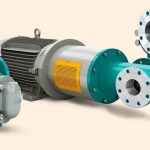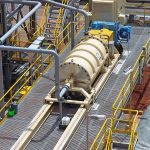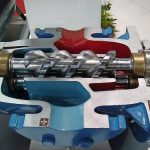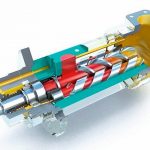Pressure is a decisive factor in many pumping tasks in the chemical industry – for everything from sealing liquids to lubricating heavy machinery such as mills. Netzsch Pumpen Systeme has therefore developed a range of screw pumps with two, three or four screws, which can produce high pressures of up to 80 bar in limited space. Notos pumps are highly efficient to operate and achieve a long service life without costly maintenance thanks to specially adapted geometries and materials combined with hydraulic compensation.
From lubricant to foam padding
Screw pumps are highly reliable
Pressure is a decisive factor in many pumping tasks in the chemical industry – for everything from sealing liquids to lubricating heavy machinery such as mills. Netzsch Pumpen Systeme has therefore developed a range of screw pumps with two, three or four screws, which can produce high pressures of up to 80 bar in limited space. Notos pumps are highly efficient to operate and achieve a long service life without costly maintenance thanks to specially adapted geometries and materials combined with hydraulic compensation.
A key feature of Notos pumps is their extreme robustness, which is essential for reliable operation under the conditions to which the screw pumps are exposed. The three-screw 3NS model, for example, is used in a ball mill for minerals to lubricate the primary input shaft. This machine is also designed to crush mineral ores such as iron and gold, which require very heavy grinding elements as well as a heavy rotating drum. To supply lubricants to the bearings under these conditions, the pump has to work against as much as 80 bar – a major strain on all components.
Hydraulic compensation
The pump’s ability to withstand that strain is in part thanks to the extremely hard materials. Cast iron, stainless steel, Duplex or Hastelloy is used depending on the particular application. This ensures that the screws themselves only deflect minimally at high loads – something which could otherwise cause increased friction and damage. Hydraulic compensation, achieved via the special Netzsch design of the lobe rotors, also mitigates these effects, thanks to the connection between the high pressure and intake sides. The pressure in specific areas, such as the seal chamber and the surfaces of the auxiliary screws, is thus reduced to the level of the intake pressure to prevent axial forces from pushing the auxiliary screws towards the intake side; this would lead to higher energy consumption as a result of increased friction and shorten the service life. Instead, these forces are cancelled out, so that the net axial force in this solution is zero. Separate bearing bushes additionally absorb the axial and radial forces while the screws are running and prevent undesirable, high-wear contact between components.
The geometry of the screws and the housing is optimised to rule out turbulence, pulsation and vibration when conveying media. The pump components are therefore protected along with the medium. All Netzsch pumps are tailored to the application in question, for example in terms of size and speed. This decreases the risk of wear and damage and ensures a long service life without costly maintenance.
Robustness at high pressures was also a decisive criterion for a manufacturer of sealing solutions, where the 3NS pumps are used to insert sealing liquid into double seals. Diesel, lubricating oil or another compatible medium can be employed as a hydraulic barrier, though the barrier pressure must always be higher than the process pressure in order to create an effective seal against the atmosphere. Only displacement pumps can guarantee the required values, yet the entire system has to be kept as small as possible. The compact screw pump was chosen because progressing cavity or rotary lobe pumps cannot deliver high pressures, or only at the price of extra space.
Special geometry for high efficiency
The novel design features of the Notos models – from the choice of material to the geometry based on the HEUD (High Efficiency Unique Design) principle – together result in significantly higher efficiency than is possible with traditional screw pumps. The high performance metals, for example, allow very small manufacturing tolerances between the dynamic and static parts, as the components hardly deform at all in operation. This keeps backflow to a minimum and improves the ratio of performance to input energy. The 3NS also has an innovative, patented fluid discharge, which prevents turbulence at the outlet and hence higher energy consumption. The combination of a double outlet and a conical widening at the end of the drive screw provides a smooth flow, so that the pumped material can flow out free of turbulence. The outlet is angled slightly to match the direction of flow within the pump chamber to support this effect and reduce the otherwise common losses of pressure and speed.
This high efficiency, coupled with a long service life, facilitates a variety of successful applications – such as lubricating mechanical reels in paper production. In this hotly contested market, even small cost benefits are significant, which is why the plant manufacturer installed two Notos pumps for different reel sizes and weights: a 3NS for conveying lube oil pressures of up to 80 bar and a 2NS for pressures of up to 16 bar. Although the two-screw pump is smaller, it has a maximum delivery rate of 320 m3 compared to 100 m3 for the 3NS. The flow rate of any screw pump is determined by its rotational speed, screw diameter and thread pitch; the four-screw pump – the 4NS – is the high-end model with 620 m3. As the four paired screws do not touch each other, even non-lubricating fluids can be conveyed.
Many adaptation options
A range of accessories, including pressure gauges and heating, is available for all models. Netzsch also offers various options for certain design features, such as DIN, ANSI or SEA connections for integration into the customer’s main system. The pumps can be installed horizontally, vertically or even partially submerged. Other optional components include pressure relief valves, alternative seals and special couplings.
2NS and 3NS pumps with a magnetic coupling, for example, were supplied to a manufacturer of electrical appliances. This type of connection was required because the system has to convey polyols and isocyanates and the latter tend to crystallise under the influence of oxygen. If the drive shaft were to pass through the housing, there would be a risk that oxygen entering the system could affect the fluid. Contact-free power transmission via the magnetic coupling removes this risk. The storage tanks can thus be filled or emptied without any problems and the two components transported reliably to the mixer’s injection head, where they react together to produce foam for insulation and filling.
www.cpp-net.com search: cpp0315netzsch
Rainer Stettin
Rainer Stettin
CR-Key Account Manager,Netzsch
Share:










